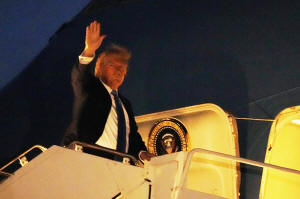Now we are six: G7 leaders try to salvage their summit after Trump's
early exit
[June 17, 2025]
By ROB GILLIES and JILL LAWLESS
KANANASKIS, Alberta (AP) — Six of the Group of Seven leaders are trying
on the final day of their Tuesday to show the wealthy nations’ club
still has the clout to shape world events despite the early departure of
President Donald Trump.
Prime Minister Mark Carney and his counterparts from the U.K., France,
Germany, Italy and Japan will be joined by Ukrainian President Volodymyr
Zelenskyy and NATO chief Mark Rutte to discuss Russia’s relentless war
on its neighbor.
World leaders had gathered in Canada with the specific goal of helping
to defuse a series of pressure points, only to be disrupted by a
showdown over Iran’s nuclear program that could escalate in dangerous
and uncontrollable ways. Israel launched an aerial bombardment campaign
against Iran on Friday, and Iran has hit back with missiles and drones.
Trump left the summit in the Canadian Rocky Mountain resort of
Kananaskis a day early late Monday, saying: “I have to be back, very
important.” It came as conflict between Israel and Iran intensifies and
the U.S. leader declared that Tehran should be evacuated “immediately” —
while also expressing optimism about a deal to stop the violence.
Before leaving, Trump joined the other leaders in issuing a statement
saying Iran “can never have a nuclear weapon” and calling for a
“de-escalation of hostilities in the Middle East, including a ceasefire
in Gaza.” Getting unanimity — even on a short and broadly worded
statement — was a modest measure of success for the group.

At the summit, Trump warned that Tehran needs to curb its nuclear
program before it’s “too late.” He said Iranian leaders would “like to
talk” but they had already had 60 days to reach an agreement on their
nuclear ambitions and failed to do so before the Israeli aerial assault
began. “They have to make a deal,” he said.
Asked what it would take for the U.S. to get involved in the conflict
militarily, Trump said Monday morning, “I don’t want to talk about
that.“
But by Monday afternoon, Trump warned ominously on social media,
“Everyone should immediately evacuate Tehran!” Shortly after that, Trump
decided to leave the summit and skip a series of Tuesday meetings that
would address the war in Ukraine and trade issues.
The sudden departure only heightened the drama of a world that seems on
verge of several firestorms. Trump already has imposed severe tariffs on
multiple nations that risk a global economic slowdown. There has been
little progress on settling the wars in Ukraine and Gaza.
Trump’s stance on Ukraine puts him fundamentally at odds with the other
G7 leaders, who back Ukraine and are clear that Russia is the aggressor
in the war.
[to top of second column]
|

President Donald Trump boards Air Force One at Calgary International
Airport, Monday, June 16, 2025, in Calgary, Canada, on his way back
to Washington. (AP Photo/Mark Schiefelbein)

The U.S. president on Monday suggested there would have been no war
if G7 members hadn’t expelled Putin from the organization in 2014
for annexing Crimea.
Trump on Monday demurred when asked if he supported Russia, saying
“I only care about saving lives.”
With talks on ending the war at an impasse, Starmer said Britain and
other G7 members were slapping new tariffs on Russia in a bid to get
it to the ceasefire negotiating table. Ukraine’s President Volodymyr
Zelenskyy is due to attend the summit Tuesday at Carney’s
invitation, along with other leaders including Indian Prime Minister
Narendra Modi and NATO chief Mark Rutte.
Trump declined to join in the sanctions on Russia, saying he would
wait until Europe did so first.
“When I sanction a country that costs the U.S. a lot of money, a
tremendous amount of money,” he said.
Trump had been scheduled before his departure to meet with Zelenskyy
and with Mexican President Claudia Sheinbaum.
On the Middle East, Merz told reporters that Germany was planning to
draw up a final communique proposal on the Israel-Iran conflict that
will stress that “Iran must under no circumstances be allowed to
acquire nuclear weapons-capable material.”
Trump also seemed to put a greater priority on addressing his
grievances with other nations’ trade policies than on collaboration
with G7 allies. The U.S. president has imposed 50% tariffs on steel
and aluminum as well as 25% tariffs on autos. Trump is also charging
a 10% tax on imports from most countries, though he could raise
rates on July 9, after the 90-day negotiating period set by him
would expire.
He announced with Starmer that they had signed a trade framework
Monday that was previously announced in May, with Trump saying that
British trade was “very well protected’ because ”I like them, that’s
why. That’s their ultimate protection.”
___
Associated Press writers Will Weissert in Banff, Alberta, and Josh
Boak in Calgary, Alberta, contributed to this story.
All contents © copyright 2025 Associated Press. All rights reserved |